Year in Review: Our Top Stories of 2024
From hidden remnants of old Penn Station to our favorite NYC book recs, discover which stories you read most last year!


The first museum in America dedicated to climate action accessibility and free climate change education occupies a quaint storefront at 105 Wooster Ave in Soho. The Climate Museum pop-up space opened for the first time in October of 2022 and was open until April 2023. Since then, the museum has been revamped and reopened. The space now features a grayscale-to-color theme and new exhibits focused on fossil fuel injustice. In this edition of NYC Makers, we spoke with Miranda Massie, founder and director of The Climate Museum, about what New Yorkers can expect to see from this year’s pop-up, and where her journey in environmental justice began.
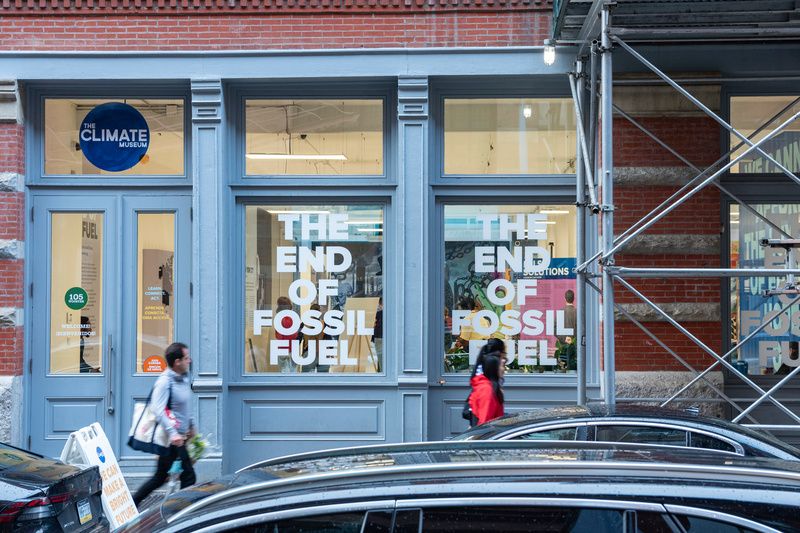
Before launching a non-profit that offers leadership opportunities to high schoolers around the state and sends letters from New York residents directly to government reps every month, Miranda was a lawyer. After a long career in civil rights trial litigation and witnessing the carnage of superstorm Sandy in real time, she felt a pull towards more direct climate action work. In 2014, she left law behind and began creating an organization that no other city had seen before: The Climate Museum. For years, The Climate Museum has spread the work of climate justice artists throughout the city, and Miranda’s plans for this season’s pop-up continue the museum’s already active momentum. You can view the museum’s exhibits for free Wednesday through Sunday from 1pm-6pm until January, 2024.
Miranda: The most important thing that everybody can do is to start talking about their feelings and thoughts about the climate and the ecological crisis that we face. It sounds like a really small thing, but it’s quite a difficult thing if you’re not in the habit of doing it. So take heart, and just get started and you’ll find that you create a ripple effect in your circles of trust and influence. And then second, it seems like a small thing, but it’s hard. Second, what we really need is a shift across our culture where people are expressing what they feel about climate. We have a really huge super-majority for climate justice policies in the U.S., like 70% of people support things like the Green New Deal, reparative payments to communities of color that have been used for fossil fuel sacrifice zones, and other very climate-forward and climate-justice-forward policies, but it’s a majority that’s self-silencing because we think we’re a tiny minority. So just by talking about it, you’re starting to make a huge difference. And the other advice I have for everyone is to come visit us at the Climate Museum because we have a lot of other very practical, very concrete tips on things anybody can do to start making a difference and understanding how meaningful that is.
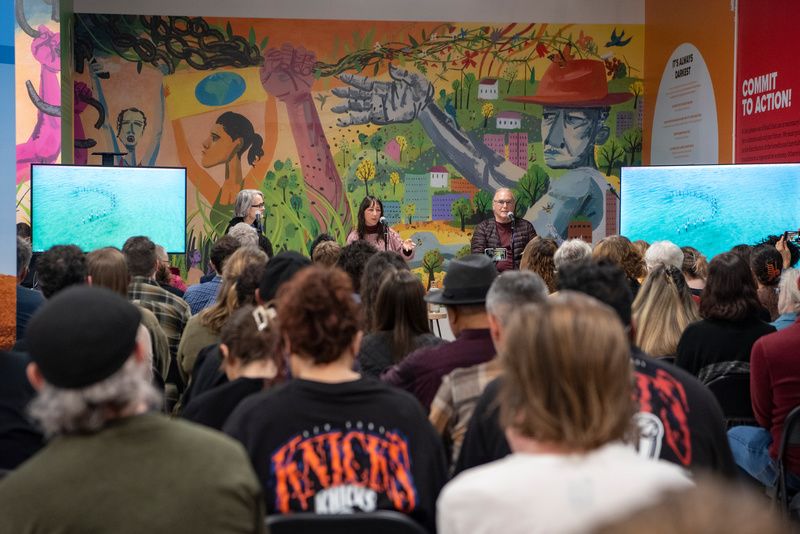
Miranda: The idea for a museum dedicated to climate change that could make climate action accessible to members of the general public, people who weren’t already committed climate activists, seems so obvious to me, and it came to me so fully formed that I 100% assumed that I’d read about a climate museum somewhere and was hazily half-plagiarizing. I was astounded to discover that we didn’t already have one in the U.S. and that this time, which is now going back almost 10 years, there was only one in the world on the outskirts of Hong Kong. And that amazed me then, and it amazes me now. But I’m happy to say in the U.S., there are now two other museums that are climate-dedicated. There’s a Museum of Climate Justice in Houston. We spoke to those founders for quite a while when they were getting things going. And there’s a Museum of Climate Action in Chicago. And the founders were inspired by our work.
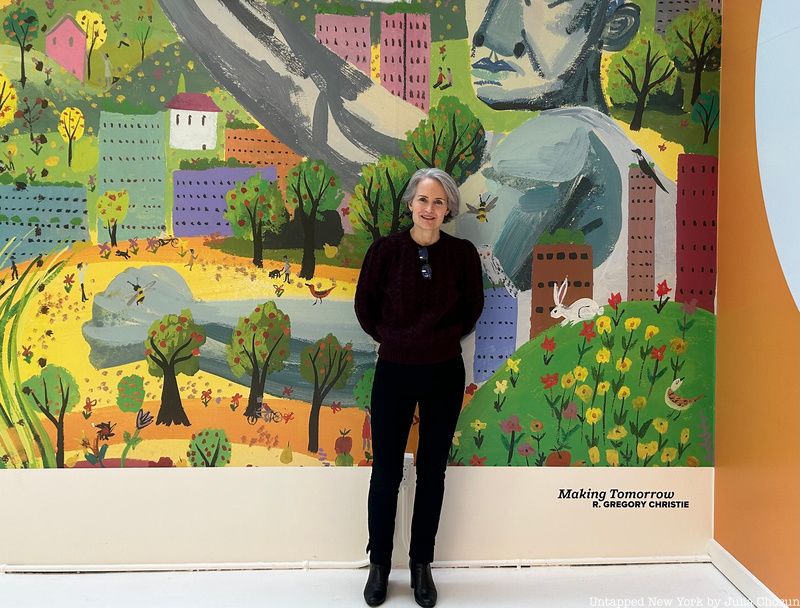
Miranda: I love our climate justice mural, which goes from grayscale, this whole side of the room is grayscale, and then the mural is the moment where we transition from the extractive industrialism of the past through the struggle for climate justice, which is where we are now. Some grief and powerful climate emotions and protests. And then, I love all the little details. Our brilliant artist worked in here. All the people in different ways, holding hands and conversing with each other. And the more time you spend looking at it, the more you see. There’s one pair of people where they’re, oh, here it is. I love this human gesticulating wildly in conversation. We think of the fossil fuel industry as being so powerful. And in one way, it is. But the reason that they spend millions of dollars lying to us all the time is because their social license is really flimsy and weak. So they have to keep propping it up. And people all around the world at different scales and in different ways are taking tons of anti-fossil fuel action.
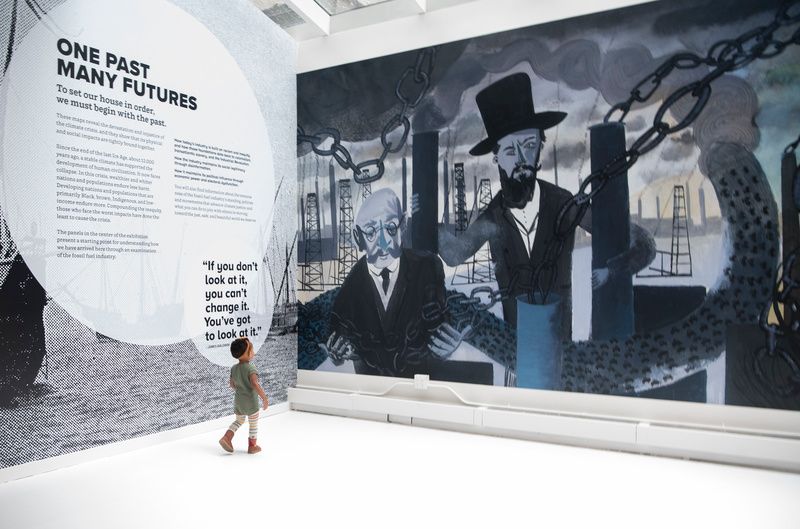
Miranda: The thing I have to call out here is our Action Station. I think this is one of the most important things that we do and something that distinguishes us from a lot of cultural institutions. We provide our visitors with very clear guidance and suggestions on specific, high-impact climate justice actions they can take and then invite them to make a commitment in a way that allows them to see, over time, the sticker wall will become plastered with stickers. It starts blank and at the end, it’s like a fungal network in a forest. I was worried people were going to start covering the art. It was awesome. People, by putting stickers up here, start to see they’re part of a broad community that supports action for climate justice. And that is, if there’s one thing that we exist to do, it’s to mobilize arts and cultural work to help people see their own power to take meaningful action. And that happens at this wall. There’s a really great one that went up the very first day. There’s a lot that I love here but there’s one that says, “I will hope and fight.” I love that. That’s a great combination. Hope alone is a bit passive. We have that big quote up front that says, we cannot afford the luxury of either hope or despair. And in one version of hope, I 100% think that’s right. Because it’s all about the fight. It’s about we have to make this fight. And frankly, we have to make it not knowing what the outcome will be. We’re not guaranteed a victory. That’s always true in any big, important fight. The outcome is not guaranteed, but the fact of making the fight gives you hope. It gives the people around you hope, and it makes a just future possible.
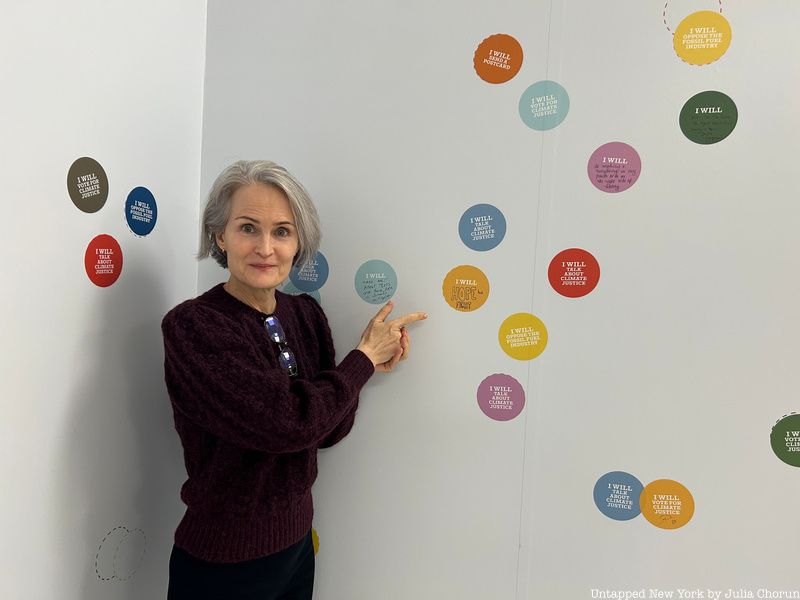
Miranda: People are doing an immense amount of reading because people are so interested in this subject. So even though this is a lot of text in the middle of the room, people are taking it in. They’re reading it. People are really interested in this subject and its showing and how they’re showing up in the space. So that’s very positive. In this world full of sound bites and 280-character limits, it’s very, very reassuring and inspiring. So even though this is a lot of text in the middle of the room, people are taking it in. One of the key actions is just talking about climate justice, but here we have some flow codes for more tips to get you started and then some basics on the front. we have three postcards taken from the mural that you can send either to your representatives in Washington or to John Kerry, who’s the US climate envoy, or if you want to Mayor Eric Adams about New York City’s climate justice policies, but communicating in writing with your reps at whatever level is super effective because they know that for every single postcard they get, there’s hundreds, if not thousands, of other people who have the same opinions, but who just aren’t, like, bothering to send a postcard. So that’s a key mechanism.
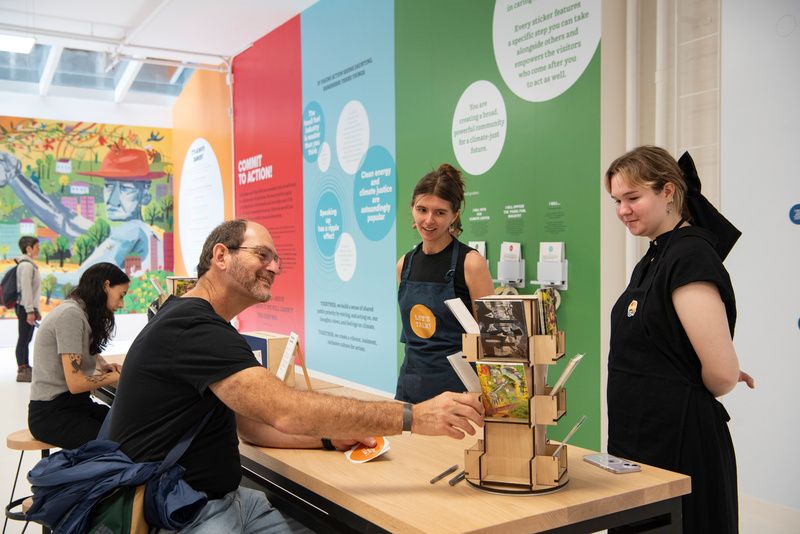
Miranda: Greenhouse gases emitted mostly by the fossil fuel industry trap heat in the atmosphere and they’re now causing mayhem all around us. That’s it. People sometimes feel nervous that they don’t understand the details, but there’s no need to understand the details. The greenhouse gases act like a heat-trapping blanket and they come from fossil fuels that the industry insists on continuing to emit. That’s really the end of that paragraph. But the most important thing for people to know about climate and the environment is that they can make a meaningful difference by taking civic action, especially if they do it in the community with others. That’s something very few people understand about themselves, that they have the power to make a real difference. And if more of us did understand it, scratch that. WHEN more of us do understand it, we’ll be moving toward a bright future. That’s the key ingredient.
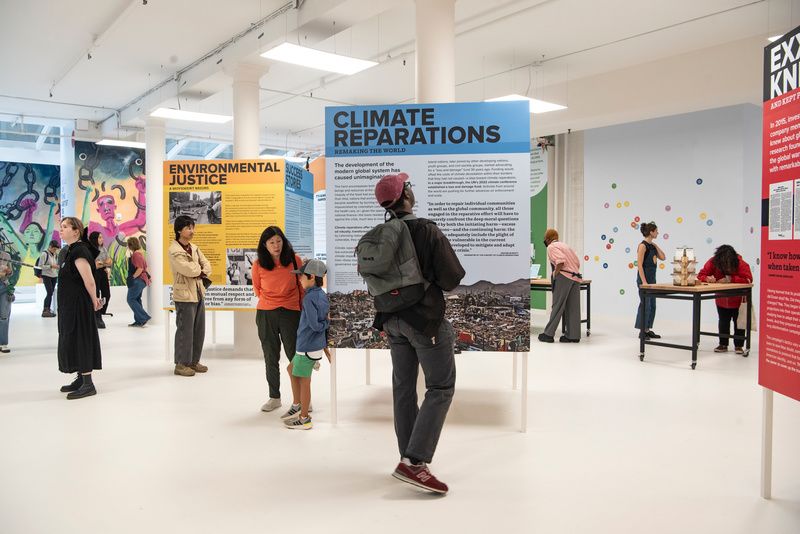
Miranda: On the contrary, I’ve been consistently surprised by the appetite we see across the public for the work that we do. People of all different ages, from all different parts of not just New York City, but the country and the world. People at all different levels of climate experience and sophistication. People from different racial and economic backgrounds. The appetite for engaging with the climate crisis in a way that’s accessible and critically, that provides an activist outlet, which all of our work always does, is consistent and deep and inspiring. So it has not been, there are other things about the museum that are difficult, but the interaction with the public is consistently super rewarding, super inspiring, and that’s because people are so hungry for this engagement. A lot of people are very cut off from nature, but people are increasingly aware of how bad it’s getting. You know, with the sky’s apocalypse orange earlier this year. There have been a lot of wake-up calls lately. And I also think even before the disasters of the last six months, for years, a large majority of Americans have understood that this is happening and that it poses immense risk to our shared prospects. What keeps people from talking about it and taking action on it is the sense that they’re alone and isolated in having strong feelings about it. The challenge is in getting the word out, in making it accessible enough to enough people. Once people learn about it, or walking by on the street decide to pop in, the level of interest and concentration and recognition of one’s own ability to change, to learn something new and understand your own social power and capacity in a different way is really incredible and very consistent.
Miranda: Subway accessibility. So Soho is not at all an accessible place to live because the rents are very high, but for us social accessibility in New York City means being close to as many subways as possible and Soho is perfect for that. Our current goal is to have a longer-term lease. It makes no sense for us to continue to have to move. That’s really a question of using this exhibition and other work that we do to attract this financial support that’s needed to sign a long-term lease. But we would love to be in a space for five years and not have to move all the furniture and fixtures, but also be able to develop the space and to be a place where people can come back to and bring their friends to, where it’s a known location. It’s just that the level of institutionalization is very helpful to us in practical terms, but more importantly, it advances the mission.
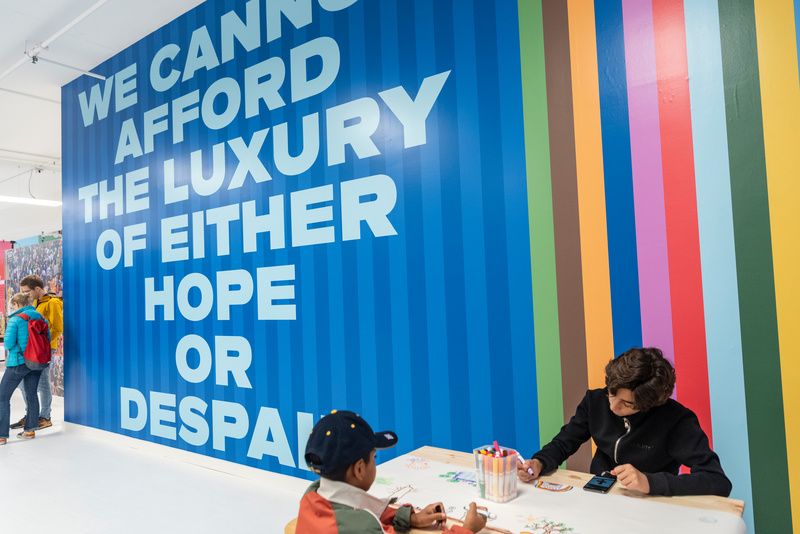
Miranda: I’m a big city-country divide person. I have both very deeply built into me. I grew up in both Brooklyn and the mid-Hudson Valley region, where my mom still lives. So I visit there a lot. I have not spent a lot of time in my life in the suburbs, but I have really strong attachments both to the city and the country. So free time in both feels almost essential to me.
Miranda: The inequality, the gross inequities that we see all around us all the time, the level of human suffering on the sidewalk in everybody’s morning and evening commute is disgraceful.
Miranda: Ornithology is a jazz club in Bushwick that is awesome and two good friends Peter Watrous and Simón Willson, play there often. So both because it is fantastic and the music is great in general and because two wonderful people I know play there a lot, I recommend it highly.
Miranda: It’s vibrancy, the human diversity, the cosmopolitanism, the energy of the city are peerless in my experience. I’ve had the amazing good fortune of traveling to a lot of spectacular cities. And at the end, if forced to choose between the city and the country, I would choose the city. And New York City is by far my favorite. The dynamism and talent that are concentrated here is unmatched anywhere.
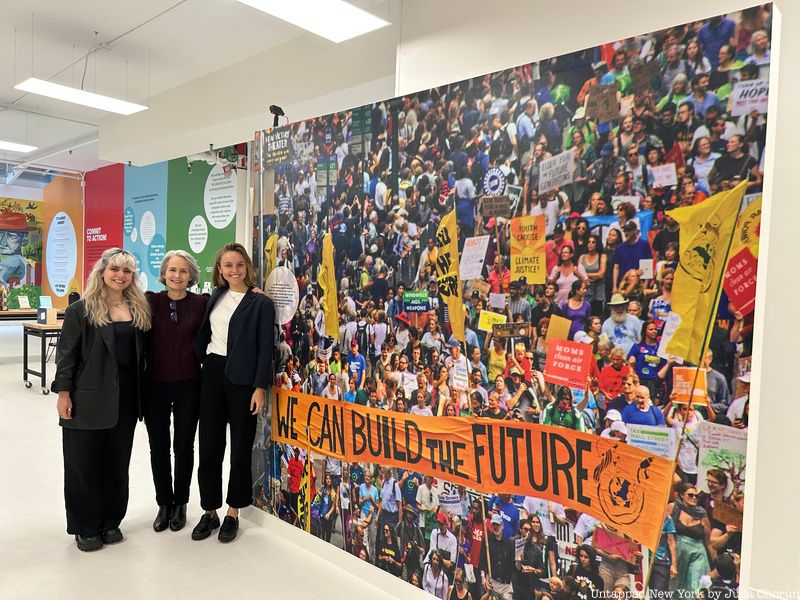
Miranda: Ideally, where I am right now, but with the museum having achieved a longstanding location and financial stability and, to be even more blunt, a reasonable level of staffing. So where I would love to be in 10 years is in my current role at the museum, but with our work situated in a way and expanded in a way that even more people can get access to it and benefit from it and become part of an active climate justice super majority.
Saskia: I started in 2018 as an intern and joined full-time in 2019. So it’s been over five years now that I’ve been with the museum and working with Miranda is amazing because she is so open to all of us, kind of learning alongside each other and it’s really a place where the growth mindset is prioritized and no one has started, or at least in the U.S,, no one has started a climate museum. We’re all kind of on the journey together, and it’s a very supportive environment and team, and I really appreciate that we’re all encouraged to try new things and learn along the way.
Amanda: I’ve been working with Miranda since like 2015, and it’s been really inspiring because when I first started working with her, this museum was kind of just an idea. It was still in the startup phase. So I’ve really seen it be able to grow and her foster this organization that now exists in like the tangible sense that now people can come and receive our works. So that’s been a really rewarding experience and just to be able to kind of like see how she’s been able to make this organization what it is today and foster the team that we have and then the community that now exists for other people to join here at our spaces has been really great.
Next, check out The Climate Change Clock in Union Square
Subscribe to our newsletter